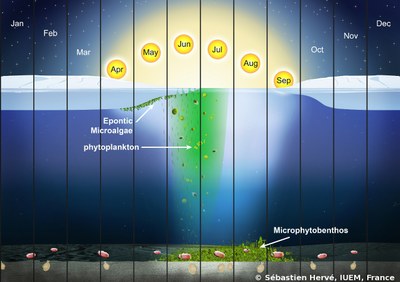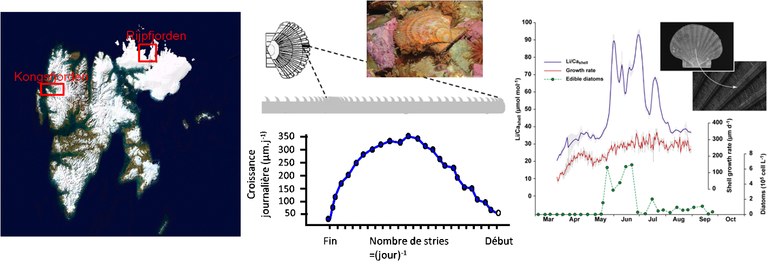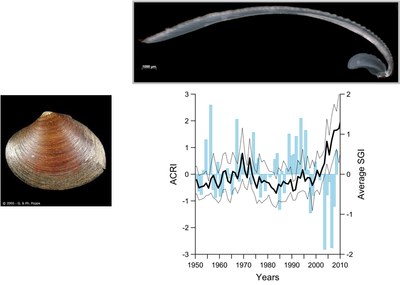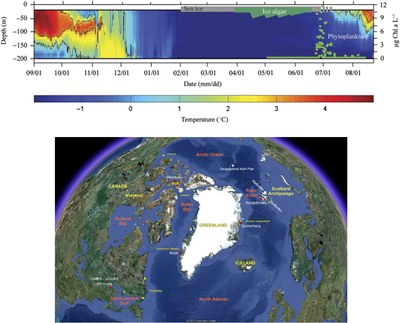Scientific Project
|
| |
|---|---|
BB. PolarPan-arctic bivalves as polar bioarchives
Scientific project |
It is now commonly accepted that the Arctic Ocean is the region where changes in climate, hydrography and ecology, related to global warming, are expected to be strongly expressed hence, the Arctic can serve as a harbinger of global change. The vast Arctic shelves are likely to be particularly sensitive because of their shallowness, their seasonally varying ice cover, and their dependency upon inflowing waters from the southward oceans and continents.
 Pelago-benthic coupling has repeatedly been demonstrated as a key process of marine ecosystems, as it ultimately determines the level of food supply to the benthos. In polar waters, sea-ice cover strongly influences the strength of pelago-benthic coupling. Leu et al. (2011) suggested that the timing of primary production is probably the single most essential factor deciding the recruitment success or failure in pelagic secondary producers, and hence, the efficiency of transfer of biomass and energy to higher trophic levels. However, the quantity and quality of the algal food available, together with seawater temperature, have also been shown to be crucial for optimal reproduction and development.
Pelago-benthic coupling has repeatedly been demonstrated as a key process of marine ecosystems, as it ultimately determines the level of food supply to the benthos. In polar waters, sea-ice cover strongly influences the strength of pelago-benthic coupling. Leu et al. (2011) suggested that the timing of primary production is probably the single most essential factor deciding the recruitment success or failure in pelagic secondary producers, and hence, the efficiency of transfer of biomass and energy to higher trophic levels. However, the quantity and quality of the algal food available, together with seawater temperature, have also been shown to be crucial for optimal reproduction and development.
The potential for sea ice to recede with climate change highlights the need to develop a predictive understanding of how Arctic marine ecosystems will evolve with changes in sea ice distribution and thickness. This requires a good understanding of ecosystem structure and functioning and how it relates to environmental drivers.
Even given the proposed resilience and adaptability of Arctic systems in general, a climate change being so drastic that it results in a shift from a "cold/abundant ice" to a "warm/limited ice" mode will probably have profound ecological consequences propagating through all trophic levels, as sea-ice dynamics is the prime physical factor driving marine Arctic biology from cellular physiology and biochemistry to food web and habitat structure. In general, there would be a shift in the relative importance of sea-ice, pelagic and benthic biota in the overall carbon flux from "sea-ice algae-benthos" to "phytoplankton-zooplankton" dominance. It is also hypothesized that in shallow areas, microphytobenthos production will be enhanced. Yet, it remains unclear how key pelagic and benthic organisms will respond to those changes in food sources (phytoplankton, sea ice algae and microphytobenthos) and environmental conditions.
Many studies on Arctic benthic communities have proven their sensitivity to environmental changes over decadal scales. While these studies provide insight into the long-term changes taking place in the benthos in response to different overriding physical conditions, most lack a strong temporal component, i.e. their data is from sampling in discreet and widely separated points in time. Thus, while studies can provide evidence of an effect, they cannot elucidate the mechanisms by which these changes take place. In the present era of changing climate in the Arctic, it is essential to understand not only the composition of benthic communities, but also how they are linked to environmental processes if we hope to be able to anticipate the potential responses of these systems to climate change.
In this context, we will develop a coupled approach of sclerochronology - sclerochemistry and physiology methods in order to establish the link between biotic and abiotic factors and the bivalves' growth at the pan-Arctic scale using two bivalves species: the Iceland scallop Chlamys islandica and the Astarte spp. Using this couple of species will enable us to work at different time scales: from daily to annual scale for Chlamys islandica and from seasonal to decadal scale for Astarte spp.
The main objective of this project is to depict the environmental signal within the shells of these two bivalves' species. The signal incorporated in the shell results, indeed, partly from the environment but also from metabolism. A phase of calibration is necessary to uncouple these two signals. The different issues addressed in this project will be investigated at different geographic scales, from the fjord to a pan-Arctic view.
Objective N°1 : Proxies’ calibration and validation on Chlamys islandica
This first step is to let the animals grow in a natural environment in which environmental dynamics are described. Thus, we will instrument Kongsjorden at two sites near the populations of scallops (Kongsfjordneset wall) and of Astarte (near Ny-Ålesund harbor). we will study a posteriori the growth and the chemical composition of shells (elemental and isotopic) from individual previously marked with calcein at the end of 2013.

Objective N°2 : Long-term environmental description

Objective N°3 : Pan-Arctic environmental description
Calibration environment / growth / chemistry being made, it is possible to use these tools by changing spatial and temporal scales. We will be able to go back in time using the long-lived species and a concerted sampling effort between Norway, Greenland and Canada will allow us to apply these tools in a pan-Arctic approach.

For more information, here is the project.

